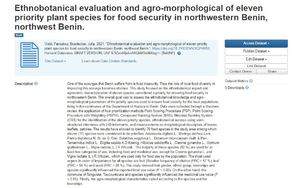Ethnobotanical evaluation and agro-morphological of eleven priority plant species for food security in northwestern Benin, northwest Benin.
One of the scourges that Benin suffers from is food insecurity. Thus the role of local food diversity in improving this scourge becomes obvious. This study focused on the ethnobotanical aspect and agronomic characterization of eleven species considered a priority for ensuring food security in northwestern Benin. The overall goal was to assess the ethnobotanical knowledge and agro-morphological parameters of the priority species used to ensure food security for the local populations living in the communes of the Department of Atacora in Benin. Data were collected through a literature review, the application of four prioritization methods Point Scoring Procedure (PSP), Point Scoring Procedure with Weighting (PSPW), Compound Ranking System (BRS), Binomial Ranking System (CRS) for the identification of the eleven priority species, ethnobotanical surveys using semi-structured interviews with 240 informants, and measurements on morphological descriptors of leaves, leaflets, petioles. The results have allowed to identify 70 food species in the study area among which eleven (11) species were considered to be priorities: Adansonia digitata L., Moringa oleifera Lam., Parkia biglobosa R. Br. ex G. Don, Balanites aegytiaca L., Detarium microcarpum Guill. & Perr., Tamarindus indica L., Blighia sapida K.D.Koenig, Hibiscus sabdariffa L., Cleome gynandra L., Ocimum gratissimum L., Vigna radiata (L.) R.Wilczek.. The majority of these species (82 %) are used for at least two categories of use, including food and medicinal use, except for Cleome gynandra L. and Vigna radiata (L.) R.Wilczek., which are used only for food use by the population. The most used organs in order of importance for all species are fruit (Relative frequency of citation (FRC = 57 %), leaf (FRC = 55 %) and seed (FRC = 28 %). The study showed that gender, ethnic group, townships and species significantly influenced the reported food use value (P < 0.05). On the other hand, the commune of Tanguieta, Toucountouna and species significantly influenced the medicinal use value (P < 0.05). Finally, the agro-morphological characteristics varied according to the species and the townships.

